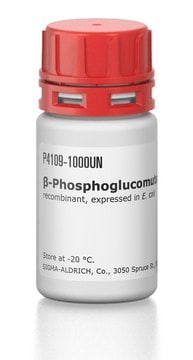P3397
Phosphoglucomutase from rabbit muscle
ammonium sulfate suspension, ≥100 units/mg protein
Sinónimos:
PGM, α-D-Glucose-1,6-bisphosphatase, α-D-Glucose-1-phosphate phosphotransferase
About This Item
Productos recomendados
origen biológico
rabbit muscle
descripción
ammonium sulfate suspension, >=100 units/mg protein
formulario
ammonium sulfate suspension
actividad específica
≥100 units/mg protein
condiciones de almacenamiento
(Tightly closed)
técnicas
activity assay: suitable
color
white to light yellow
actividad extraña
lactic dehydrogenase ≤0.5%
phosphoglucose isomerase ≤0.01%
pyruvate kinase ≤0.05%
Condiciones de envío
wet ice
temp. de almacenamiento
2-8°C
¿Está buscando productos similares? Visita Guía de comparación de productos
Descripción general
Phosphoglucomutase (PGM), a conserved enzyme, is abundantly found in animals, plants, and microorganisms. It is distributed in almost all tissues.
Aplicación
- to study glycogenesis and phosphoglycomutase deficiency in humans
- in phosphoglucomutase assays to study metabolic regulation
- for assay A to assay enzymes closely linked to glycogen metabolism in transformed BL21(DE3)C43 cells
- in sucrose synthase (SuSy) andADPglucose pyrophosphorylase (AGPase) assays(3)
- in enzyme activity assay for coupling the reduction of nicotinamide adenine dinucleotide phosphate (NADP+)to determine glucose-1-phosphate from sucrose and inorganic phosphate (Pi)
Acciones bioquímicas o fisiológicas
Definición de unidad
Forma física
Nota de análisis
anticuerpo
enzima
Código de clase de almacenamiento
12 - Non Combustible Liquids
Clase de riesgo para el agua (WGK)
WGK 2
Punto de inflamabilidad (°F)
Not applicable
Punto de inflamabilidad (°C)
Not applicable
Equipo de protección personal
Eyeshields, Gloves, multi-purpose combination respirator cartridge (US)
Certificados de análisis (COA)
Busque Certificados de análisis (COA) introduciendo el número de lote del producto. Los números de lote se encuentran en la etiqueta del producto después de las palabras «Lot» o «Batch»
¿Ya tiene este producto?
Encuentre la documentación para los productos que ha comprado recientemente en la Biblioteca de documentos.
Los clientes también vieron
Artículos
Instructions for working with enzymes supplied as ammonium sulfate suspensions
Nuestro equipo de científicos tiene experiencia en todas las áreas de investigación: Ciencias de la vida, Ciencia de los materiales, Síntesis química, Cromatografía, Analítica y muchas otras.
Póngase en contacto con el Servicio técnico










